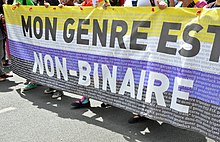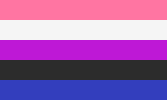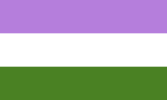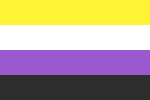ノンバイナリー・ジェンダー
 | 日本で使用されるジェンダー・アイデンティティを表す用語については「Xジェンダー」をご覧ください。 |
| LGBT関連シリーズ |
| LGBTのトピック |
|---|
| レズビアン ∙ ゲイ ∙ バイセクシュアル ∙ トランスジェンダー |
|
| 歴史(英語版)
|
|
|
 LGBTポータル LGBTポータル |
|
| Part of a series |
| トランスジェンダーのトピック |
|---|
| 歴史(英語版)
|
| 医療(英語版)
|
| 権利と法的問題
|
| 理論と概念
|
| 国別
|
 LGBTポータル LGBTポータル |
|
ノンバイナリー(英語: non-binary)[注釈 1]およびジェンダークィア(英語: genderqueer)は、男性または女性だけではないジェンダー・アイデンティティ(ジェンダー・バイナリーの外にあるアイデンティティ)を意味するアンブレラタームである[2][3]。通常、ノンバイナリーの人々は、出生時に割り当てられた性別とは異なる性別を自認するため、ノンバイナリーのアイデンティティはトランスジェンダーの1つと考えられることが多い[3]。ただし、ノンバイナリーの人々の中には、自分をトランスジェンダーだと考えない人もいる[4][5]。
ノンバイナリーの人々は、中間的なジェンダーや第3の性別を自認する場合[6]、複数のジェンダーを自認する場合[7][8]、ジェンダーを持たない場合、あるいは、流動するジェンダー・アイデンティティを持つ場合がある[9]。ジェンダー・アイデンティティは、性的指向や恋愛的指向とは別のものであるため[10]、ノンバイナリーの人々は人によってさまざまな性的指向を持つ[11]。
ノンバイナリーはインターセックスとは異なる。ほとんどのインターセックスの人々は男性または女性のいずれかを自認するが[12]、ノンバイナリーのみを自認する人もいれば、Hida Viloria(英語版)のように、ノンバイナリーかつジェンダー・フルイドを自認する人もいる。また、ノンバイナリー男性や、ノンバイナリー女性を自認する人もいる。
グループとしてのノンバイナリーの人々は、ジェンダー表現はさまざまに異なり、中にはジェンダー・アイデンティティを完全に否定する人もいる[13]。ノンバイナリーの人々の中には、性別違和によって引き起こされる精神的な苦しみを軽減するために、性別適合手術やホルモン補充療法(英語版)などのジェンダー・アファーミング・ケア(英語版)を受けている人もいる[14]。
用語と定義
「ジェンダークィア(genderqueer)」という用語は、より広く使用されている「ノンバイナリー(non-binary)」の前に、1980年代のクィアZINEで初めて登場した[15]。この用語は、1990 年代にRiki Anne Wilchins(英語版)[16]などの活動家によって有名になった[17]。Rikiは、1995年のエッセイと1997年の自伝で、伝統的なジェンダー規範の外にいる個人を説明するためにこの言葉を使用した[18][19]。2002年までに、この用語はアンソロジー『Genderqueer: Voices Beyond the Sex Binary』を通じてさらに普及した[20]。2010年代のインターネットの普及や著名人による公の場での自認により、ジェンダークィアは一般にも認識されるようになった[17]。
「ジェンダークィア」は、ノンバイナリーのアイデンティティを包括する用語であると同時に、個人のアイデンティティに関係なく、従来のジェンダーの区別に挑戦したりそこから離れたりする個人を表す形容詞としても機能する。ジェンダークィアには、「男性」と「女性」という典型的なバイナリーの分類を超えた幅広いジェンダーの表現が含まれる[21][22]。
さらに、「ジェンダークィア」はジェンダーの曖昧さと関連付けられており[23]、「アンドロジナス(またはアンドロジニー)」は、社会的に定義された男性らしさや女性らしさの特徴の混合を説明するためによく使用される[24]。 ただし、ジェンダークィアのすべての人がアンドロジナスであると自認するわけではなく、伝統的な男性的または女性的な特徴を自分に重ね合わせたり、「男性的な女性」や「女性的な男性」のような別の表現を使用する人もいる[25]。ノンバイナリの頭文字「NB」に由来する「enby」という用語もよく使われる[26][27]。ノンバイナリーであることは、インターセックスであることとは異なり、ほとんどのインターセックスの人は自分を男性または女性のどちらかだと認識していることに注意する必要がある[12]。
「トランスジェンダー」という用語には、多くの場合、ジェンダークィアまたはノンバイナリーの人々も含まれており、幅広いジェンダーの多様性を反映している[13][28][29]。この包括的な使用法は少なくとも1992年に遡り、「ジェンダー・アウトロー(gender outlaws)」の経験の共有を強調した、レスリー・ファインバーグ(英語版)[17]やケイト・ボーンスタインのような人物からの多大な貢献があった[30]。ヒューマン・ライツ・キャンペーン財団やGender Spectrumなどの組織は、典型的には二元的なジェンダー制度に関連付けられているものよりも、より幅広いジェンダー・アイデンティティやジェンダー表現を意味するために、「gender-expansive」という用語を使用している[31]。
アイデンティティ
アジェンダー
アジェンダー(agender)は、ジェンダーやジェンダー・アイデンティティを持たないと自認している個人を指す[32][33][13]。アジェンダーは、ジェンダーレス(genderless)、ジェンダーフリー(gender-free)、ノンジェンダー(non-gendered)、非ジェンダー(ungendered)とも呼ばれる[34][35]。このグループは、従来のジェンダー規範の外にあるさまざまなアイデンティティを代表している。学者のFinn Enkeによると、すべてのアジェンダーがトランスジェンダーであると自認するわけではない[36]。アジェンダーの人々を表す代名詞として広く受け入れられているものはなく、単数のtheyが一般的に使用されているが、それがデフォルトというわけではない[37]。特に、「Agender」と「Neutrois」は、2014年2月にFacebookに、2014年11月以降OkCupidに追加されたカスタム性別オプションの1つであった[38][39]。
マルチジェンダー、ポリジェンダー
これらの用語は、複数のジェンダーを同時または交互に経験する個人を指す。このカテゴリーには、デミジェンダー、バイジェンダー、パンジェンダー、ジェンダー・フルイドなどのアイデンティティが含まれる[40][41]。それに対して、単一の変化しないジェンダーを経験する個人は、モノジェンダー(monogender)またはジェンダースタティック(genderstatic)と呼ばれる[42]。
バイジェンダー
バイジェンダー(bigender)の個人は、2つの異なるジェンダー・アイデンティティを持っており、男性的表現と女性的表現が同時に現れることもあれば、それらが変動することもある[43][44][45]。バイジェンダーは、ジェンダー・フルイドのアイデンティティとは異なる。ジェンダー・フルイドの場合、固定されたジェンダーの状態を含むのではなく、むしろジェンダーのスペクトル全体にわたる流動的な範囲を含む可能性がある[46][47]。アメリカ心理学会では、バイジェンダー・アイデンティティをより広範なトランスジェンダーのカテゴリーの一部として認めている[48]。1999年のサンフランシスコ公衆衛生局の調査や2016年のハリス世論調査(Harris poll)などの調査や研究では、特に若い世代でバイジェンダー・アイデンティティが多いことが記録されている[49][50][51]。トライジェンダー(trigender)の個人は、男性、女性、第3の性別の間で変化する[52]。
デミジェンダー
デミジェンダー(demigender)を自認する個人は、1つのジェンダーに部分的なつながりを感じながらも、同時に他のジェンダーにつながりを感じたり、全くつながりを感じなかったりする(アジェンダー(agender)と呼ばれる)[53][54]。サブカテゴリには、部分的に男性を自認するデミボーイ(demi-boy)またはデミマン(demi-man)、部分的に女性で部分的にノンバイナリーであるデミガール(demi-girl)がある。デミフラックス(Demiflux)の個人は、安定したノンバイナリーのアイデンティティを経験するとともに、他のジェンダー・アイデンティティをさまざまな強さで感じる[54]。
パンジェンダー
パンジェンダー(pangender)の個人は、複数または全てのジェンダーを自認し、時にはこれらすべてのアイデンティティを同時に経験する[55][56]。
ジェンダー・フルイド
ジェンダー・フルイドの個人は、固定されたジェンダー・アイデンティティを感じ続けるのではなく、ジェンダー表現が時間の経過とともに変化し、異なる時点でさまざまなジェンダーの要素が組み合わされる[57][57][58]。このアイデンティティは、バイジェンダー、トライジェンダー、パンジェンダーの表現と重なる場合がある[7][8]。
トランスフェミニンまたはトランスマスキュリン
トランスフェミニン(transfeminine)は、出生時に男性を割り当てられたが、自分を女性(feminine、フェミニン)であると自認または表現している個人を指す。トランスマスキュリン(transmasculine)は、出生時に女性を割り当てられたが、自分を男性(masculine、マスキュリン)であると自認または表現している個人を指す。これらの用語は、バイナリとノンバイナリの両方のアイデンティティを含む[59]。
Two-spirit
1990年にウィニペグで開催された先住民のLGBTの集まりに由来するもので、Two-spirit(英語版)という用語は、伝統的な性別の区別を超えた資質を体現したり、役割を果たしたりする、北アメリカ先住民コミュニティ内の個人を指す[60]。
ゼノジェンダー
ゼノジェンダー(xenogender)は、非伝統的な概念を使用して定義されるさまざまなジェンダーが含まれる。多くの場合、自然、無生物、または抽象的な源から引き出されるもので、典型的な人間の性別二元論からの離脱を表すものである[61][62]。
その他のアイデンティティ
その他のアイデンティティには、マーベリック(maverique)、アポラジェンダー(aporagender)、アンビジェンダー(ambigender)インタージェンダー(intergender)、ジェンダー・フルイド(genderflux)などがある。それぞれ、従来のジェンダー規範の外にある独自の視点や経験を示している[59]。
歴史


日本では、1990年代後半からノンバイナリーのアイデンティティを表す「Xジェンダー」という表現が認識されるようになり、漫画家の鎌谷悠希や渡瀬悠宇などの著名な人物もXジェンダーを自認している[66][67]。
代名詞と敬称


法的な承認

差別
シンボルと行事

-
![トランスジェンダー・フラッグでは、白色がノンバイナリーを表現している[70][71]](//upload.wikimedia.org/wikipedia/commons/thumb/b/b0/Transgender_Pride_flag.svg/167px-Transgender_Pride_flag.svg.png)
-
 アジェンダー・プライド・フラッグ
アジェンダー・プライド・フラッグ -
 バイジェンダー・プライド・フラッグ
バイジェンダー・プライド・フラッグ -
 ジェンダーフルイド・プライド・フラッグ
ジェンダーフルイド・プライド・フラッグ -
 ジェンダークィア・プライド・フラッグ
ジェンダークィア・プライド・フラッグ -

-
 トライジェンダー・プライド・フラッグ
トライジェンダー・プライド・フラッグ -
 ノンバイナリー・ジェンダーのシンボル
ノンバイナリー・ジェンダーのシンボル -
 アジェンダーのシンボル
アジェンダーのシンボル -
 ジェンダー・フルイドのシンボル
ジェンダー・フルイドのシンボル
人口統計
アメリカ合衆国
2021年のWilliams Institute(英語版)の調査によると、18歳から60歳までの推定120万人のアメリカ成人がノンバイナリーであると自認しており、同じ年齢層のLGBTQ人口の11%を占めている[72]。
The Trevor Project(英語版)による2020年の調査では、アメリカ合衆国のLGBTQの若者(13~24歳)の26%がノンバイナリーであると自認していることがわかった[5][73]。
2015年の『アメリカ合衆国トランスジェンダー調査報告書(The Report of the 2015 U.S. Transgender Survey)』によると、匿名のオンライン調査に回答した約28,000人のトランスジェンダーのうち、35%がノンバイナリーであした[74][75]。
脚注
注釈
- ^ nonbinaryと綴ることもある。NBの略記である「enby」という用語が使われることもある。[1]
出典
- ^ Bergman, S. Bear; Barker, Meg-John (2017). “Non-binary Activism”. In Richards, Christina; Bouman, Walter Pierre; Barker, Meg-John. Genderqueer and Non-Binary Genders. Critical and Applied Approaches in Sexuality, Gender and Identity. Palgrave Macmillan. p. 43. ISBN 978-1-137-51052-5
- ^ Richards, Christina; Bouman, Walter Pierre; Seal, Leighton; Barker, Meg John; Nieder, Timo O.; T'Sjoen, Guy (2016). “Non-binary or genderqueer genders”. International Review of Psychiatry 28 (1): 95–102. doi:10.3109/09540261.2015.1106446. hdl:1854/LU-7279758. PMID 26753630. https://biblio.ugent.be/publication/7279758 June 9, 2019閲覧。.
- ^ a b “Supporting & Caring for Transgender Children”. Human Rights Campaign. July 24, 2021時点のオリジナルよりアーカイブ。April 8, 2021閲覧。
- ^ “Trans + Gender Identity”. The Trevor Project. オリジナルのJuly 4, 2018時点におけるアーカイブ。. https://web.archive.org/web/20180704175733/https://www.thetrevorproject.org/trvr_support_center/trans-gender-identity October 11, 2019閲覧。
- ^ a b Ennis, Dawn (July 13, 2021). “New Research Reveals Insights Into America's Nonbinary Youth”. Forbes. オリジナルのJanuary 6, 2022時点におけるアーカイブ。. https://web.archive.org/web/20220106234315/https://www.forbes.com/sites/dawnstaceyennis/2021/07/13/new-research-reveals-insights-into-americas-nonbinary-youth January 6, 2022閲覧。
- ^ "Genderqueer". glbtq: An Encyclopedia of Gay, Lesbian, Bisexual, Transgender, and Queer Culture.
- ^ a b Bosson, Jennifer K.; Vandello, Joseph A.; Buckner, Camille E. (2018). The Psychology of Sex and Gender. Thousand Oaks, California: Sage Publications. p. 54. ISBN 978-1-5063-3134-8. OCLC 1038755742. オリジナルのMay 28, 2020時点におけるアーカイブ。. https://web.archive.org/web/20200528040645/https://books.google.com/books?id=XStGDwAAQBAJ&pg=PT54 August 4, 2019閲覧。
- ^ a b Whyte, Stephen; Brooks, Robert C.; Torgler, Benno (September 25, 2018). “Man, Woman, "Other": Factors Associated with Nonbinary Gender Identification”. Archives of Sexual Behavior (Heidelberg, Germany: Springer Science+Business Media) 47 (8): 2397–2406. doi:10.1007/s10508-018-1307-3. PMID 30255409. "2 out of 7479 (0.03 percent) of respondents to the Australian Sex Survey, a 2016 online research survey, self-identified as trigender."
- ^ Winter, Claire Ruth (2010). Understanding Transgender Diversity: A Sensible Explanation of Sexual and Gender Identities. Scotts Valley, California: CreateSpace. ISBN 978-1-4563-1490-3. OCLC 703235508
- ^ “Transgender Glossary of Terms”. GLAAD Media Reference Guide. Gay & Lesbian Alliance Against Defamation. May 30, 2012時点のオリジナルよりアーカイブ。May 25, 2011閲覧。
- ^ Stryker, Susan (2008). Transgender History. Berkeley, California: Seal Press. ISBN 978-1-58005-224-5. OCLC 183914566
- ^ a b “Understanding Non-Binary People: How to Be Respectful and Supportive”. National Center for Transgender Equality (July 9, 2016). April 6, 2020時点のオリジナルよりアーカイブ。June 17, 2020閲覧。
- ^ a b c Schorn. “Taking the 'Sex' out of Transsexual: Representations of Trans Identities in Popular Media”. University of Cologne. p. 1. October 25, 2014時点のオリジナルよりアーカイブ。October 23, 2014閲覧。 “The term transgender is an umbrella term 'and generally refers to any and all kinds of variation from gender norms and expectations' (Stryker 19). Most often, the term transgender is used for someone who feels that the sex assigned to them at birth does not reflect their own gender identity. They may identify as the gender "opposite" to their assigned gender, or they may feel that their gender identity is fluid, or they may reject all gender categorizations and identify as agender or genderqueer.”
- ^ Hastings (June 17, 2016). “Approach to genderqueer, gender non-conforming, and gender nonbinary people”. UCSF Transgender Care. October 6, 2021時点のオリジナルよりアーカイブ。October 10, 2021閲覧。
- ^ Hendrie, Theo, ed (2019). X Marks the Spot: An Anthology of Nonbinary Experiences. Independently Published. p. 238. ISBN 978-1-0809-6803-9
- ^ Wilchins (March 14, 2017). “Get to Know the New Pronouns: They, Theirs, and Them”. Pride. February 18, 2020時点のオリジナルよりアーカイブ。February 18, 2020閲覧。
- ^ a b c Tobia (November 7, 2018). “InQueery: The History of the Word 'Genderqueer' As We Know It”. them. Condé Nast. April 4, 2020時点のオリジナルよりアーカイブ。February 18, 2020閲覧。
- ^ “Genderqueer History”. November 12, 2018時点のオリジナルよりアーカイブ。November 2, 2018閲覧。
- ^ Wilchins, Riki (Spring 1995). “A Note from your Editrix”. In Your Face (1): 4. http://www.gendertalk.com/pubs/InYourFace1.pdf February 18, 2020閲覧。.
- ^ Clare (ed.). GenderQueer: voices from beyond the sexual binary.
- ^ Shaw, Susan; Lee, Janet (April 23, 2014). Women's Voices Feminist Visions: Classic and Contemporary Readings (Sixth ed.). New York: McGraw-Hill Education. pp. 130; 135. ISBN 978-0-07-802700-0. OCLC 862041473
- ^ Dahir, Mubarak (25 May 1999). "Whose Movement Is It?". The Advocate. San Francisco, California: Here Media. p. 52.
- ^ Girshick, Lori B. (2008). Transgender Voices: Beyond Women and Men. Hanover, New Hampshire: University Press of New England. ISBN 978-1-58465-645-6. OCLC 183162406
- ^ Shaw, Susan M.; Lee, Janet (April 23, 2014). Women's Voices Feminist Visions: Classic and Contemporary Readings (Sixth ed.). New York: McGraw-Hill Education. ISBN 978-0-07-802700-0. OCLC 862041473
- ^ Walsh, Reuben (December 2010). "More T, vicar? My experiences as a genderqueer person of faith". All God's Children. Vol. 2, no. 3. Lesbian and Gay Christian Movement.
- ^ Sheridan, Vanessa (2018). Transgender in the Workplace: The Complete Guide. Bloomsbury Academic. p. 11. ISBN 978-1440858062
- ^ Hope, Sam (2019). Person-Centred Counselling for Trans and Gender Diverse People. London, England: Jessica Kingsley Publishers. p. 218. ISBN 978-1784509378
- ^ Vargo, Marc E. (November 30, 2011). “A Review of Please select your gender: From the invention of hysteria to the democratizing of transgenderism”. Journal of GLBT Family Studies 7 (5): 2 (493). doi:10.1080/1550428X.2011.623982. ISSN 1550-4298. "up to three million U. S. citizens regard themselves as transgender, a term referring to those whose gender identities are at odds with their biological sex. The term is an expansive one, however, and may apply to other individuals as well, from the person whose behavior purposely and dramatically diverges from society's traditional male/female roles to the "agender", "bigender" or "third gender" person whose self-definition lies outside of the male/female binary altogether. In short, those counted under this term constitute a wide array of people who do not conform to, and may actively challenge conventional gender norms."
- ^ Cronn-Mills, Kirstin (2014). “IV. Trans*spectrum. Identities”. Transgender Lives: Complex Stories, Complex Voices. Minneapolis, Minnesota: Twenty-First Century Books. p. 24. ISBN 978-1-4677-4796-7. オリジナルのApril 8, 2019時点におけるアーカイブ。. https://books.google.com/books?id=dOUSBAAAQBAJ&pg=PA24 October 23, 2014閲覧. "Many different individuals fall under what experts call the trans* spectrum, or the trans* umbrella."I'm trans*" and "I'm transgender" are ways these individuals might refer to themselves. But there are distinctions among different trans* identities. [...] Androgynous individuals may not identify with either side of the gender binary. Other individuals consider themselves agender, and they may feel they have no gender at all."
- ^ Bornstein, Kate (2013). Gender Outlaw: On Men, Women and the Rest of Us. Abingdon, England: Routledge. ISBN 978-1-136-60373-0. オリジナルのMarch 10, 2021時点におけるアーカイブ。. https://web.archive.org/web/20210310121616/https://books.google.com/books?id=_VsCl7Ek4N8C&q=All%2Bthe%2Bcategories%2Bof%2Btransgender%2Bfind%2Ba%2Bcommon%2Bground%2Bin%2Bthat%2Bthey%2Beach%2Bbreak%2Bone%2Bor%2Bmore%2Bof%2Bthe%2Brules%2Bof%2Bgender%3A%2Bwhat%2Bwe%2Bhave%2Bin%2Bcommon%2Bis%2Bthat%2Bwe%2Bare%2Bgender%2Boutlaws%2C%2Bevery%2Bone%2Bof%2Bus&pg=PT79 October 19, 2020閲覧。
- ^ “Supporting and Caring for our Gender-Expansive Youth”. Human Rights Campaign. January 29, 2016時点のオリジナルよりアーカイブ。May 21, 2021閲覧。
- ^ Vargo, Marc E. (2011). “A Review of "Please select your gender: From the invention of hysteria to the democratizing of transgenderism"”. Journal of GLBT Family Studies 7 (5): 493–494. doi:10.1080/1550428x.2011.623982.
- ^ Cronn-Mills, Kirstin (2014). Transgender Lives: Complex Stories, Complex Voices. Twenty-First Century Books. ISBN 978-1-4677-4796-7. オリジナルのDecember 2, 2016時点におけるアーカイブ。. https://web.archive.org/web/20161202005115/https://books.google.com/books?id=dOUSBAAAQBAJ February 3, 2016閲覧。
- ^ “LGBTQ Needs Assessment”. Encompass Network. pp. 52–53 (April 2013). October 24, 2014時点のオリジナルよりアーカイブ。October 18, 2014閲覧。
- ^ “Gender alphabet”. Safe Homes. p. 1. April 15, 2015時点のオリジナルよりアーカイブ。October 18, 2014閲覧。
- ^ Anne Enke, ed (2012). “Note on terms and concepts”. Transfeminist Perspectives In and Beyond Transgender and Gender Studies. Temple University Press. pp. 16–20 [18–19]. ISBN 978-1-4399-0748-1
- ^ Sojwal (September 16, 2015). “What Does 'Agender' Mean? 6 Things to Know About People With Non-Binary Identities”. Bustle. February 22, 2016時点のオリジナルよりアーカイブ。February 22, 2016閲覧。
- ^ Sparkes, Matthew (February 14, 2014). “Facebook sex changes: which one of 50 genders are you?”. The Daily Telegraph. オリジナルのMay 21, 2018時点におけるアーカイブ。. https://web.archive.org/web/20180521104128/https://www.telegraph.co.uk/technology/facebook/10637968/Facebook-sex-changes-which-one-of-50-genders-are-you.html April 5, 2018閲覧。
- ^ “OkCupid expands gender and sexuality options”. PBS NewsHour. (November 17, 2014). オリジナルのNovember 19, 2014時点におけるアーカイブ。. https://web.archive.org/web/20141119184104/http://www.pbs.org/newshour/rundown/okcupid-expands-gender-sexuality-options November 18, 2014閲覧。
- ^ “Here's What It Means to Be Polygender” (英語). Cosmopolitan (2022年1月20日). 2024年3月9日閲覧。
- ^ “What It Means To Be Multigender: The Questions Many Have But Are Afraid To Ask” (英語). The Body Is Not An Apology (2018年6月23日). 2024年3月9日閲覧。
- ^ “Gender Fluidity 101” (英語). The Everyday (2021年1月17日). 2024年3月9日閲覧。
- ^ Edwards, Ruth Dudley (August 17, 2014). “Asexual, bigender, transexual or cis, can't we all just be kind to each other?”. The Independent. オリジナルのDecember 18, 2019時点におけるアーカイブ。. https://web.archive.org/web/20191218121523/https://www.independent.ie/opinion/columnists/ruth-dudley-edwards/asexual-bigender-transexual-or-cis-cant-we-all-just-be-kind-to-each-other-30513083.html December 18, 2019閲覧。
- ^ Persio, Sofia Lotto (16 June 2017). "Oregon becomes first state to allow option "X" to end gender binary". Newsweek. 2019年12月18日時点のオリジナルよりアーカイブ。2019年12月18日閲覧。
- ^ “Everything you ever wanted to know about being nonbinary”. The Daily Dot (September 28, 2017). September 28, 2019時点のオリジナルよりアーカイブ。December 18, 2019閲覧。
- ^ “Billy Dee Williams: What is gender fluid?”. Monsters and Critics (December 2, 2019). December 18, 2019時点のオリジナルよりアーカイブ。December 18, 2019閲覧。
- ^ “This is the term for people who aren't exclusively male or female”. PinkNews (April 26, 2018). December 18, 2019時点のオリジナルよりアーカイブ。December 18, 2019閲覧。
- ^ “Sexual orientation and gender identity”. オリジナルのJanuary 2, 2020時点におけるアーカイブ。. https://web.archive.org/web/20200102055739/https://www.apa.org/helpcenter/sexual-orientation December 18, 2019閲覧。
- ^ Clements, K. San Francisco Department of Public Health Archived September 15, 2006, at the Wayback Machine., 1999
- ^ “EEOC now gives nonbinary people a way to be counted in workplace”. ThinkProgress (August 20, 2019). December 18, 2019時点のオリジナルよりアーカイブ。December 18, 2019閲覧。
- ^ “Accelerating Acceptance 2017”. GLAAD. January 6, 2020時点のオリジナルよりアーカイブ。December 27, 2019閲覧。
- ^ Bosson, Jennifer K.; Vandello, Joseph A.; Buckner, Camille E. (January 17, 2018). The Psychology of Sex and Gender. SAGE Publications. ISBN 978-1-5063-3134-8. オリジナルのAugust 3, 2021時点におけるアーカイブ。. https://web.archive.org/web/20210803194904/https://books.google.com/books?id=XStGDwAAQBAJ&q=Trigender&pg=PT54 June 22, 2021閲覧。
- ^ Gibson, Sarah; Fernandez, J. (2018). Gender Diversity and Non-Binary Inclusion in the Workplace: The Essential Guide for Employers. London: Jessica Kingsley Publishers. pp. 25. ISBN 978-1-78450-523-3
- ^ a b Brill, Stephanie; Kenney, Lisa (2016). The Transgender Teen. Berkeley, California: Cleis Press. p. 311. ISBN 978-1627781749
- ^ Ginicola, Misty M.; Smith, Cheri; Filmore, Joel M. (February 10, 2017). Affirmative Counseling with LGBTQI+ People. John Wiley & Sons. pp. 366. ISBN 978-1-119-37549-4. オリジナルのAugust 3, 2021時点におけるアーカイブ。. https://web.archive.org/web/20210803194905/https://books.google.com/books?id=pi8bDgAAQBAJ&q=polygender&pg=PA366 June 22, 2021閲覧。
- ^ “Queer Undefined”. Queer Undefined. January 21, 2021時点のオリジナルよりアーカイブ。October 10, 2020閲覧。
- ^ a b Cronn-Mills, Kirstin (2015). Transgender Lives: Complex Stories, Complex Voices. Minneapolis, Minnesota: Twenty-First Century Books. p. 24. ISBN 978-0-7613-9022-0
- ^ McGuire, Peter (November 9, 2015). “Beyond the binary: what does it mean to be genderfluid?”. The Irish Times. オリジナルのNovember 22, 2015時点におけるアーカイブ。. https://web.archive.org/web/20151122121336/http://www.irishtimes.com/life-and-style/people/beyond-the-binary-what-does-it-mean-to-be-genderfluid-1.2418434 December 1, 2015閲覧。
- ^ a b Hardell, Ash (2016). The ABC's of LGBT+. Coral Gables, Florida: Mango Media Inc.. pp. 96. ISBN 9781633534094. OCLC 962263268. オリジナルの2024-04-15時点におけるアーカイブ。. https://web.archive.org/web/20240415151942/https://www.google.co.in/books/edition/_/Q_rMzgEACAAJ?hl=en 2024年4月15日閲覧。
- ^ de Vries, Kylan Mattias (2009). “Berdache (Two-Spirit)”. In O'Brien, Jodi. Encyclopedia of gender and society. Los Angeles: SAGE. p. 64. ISBN 9781412909167. オリジナルのMay 1, 2015時点におけるアーカイブ。. https://books.google.com/books?id=_nyHS4WyUKEC March 6, 2015閲覧。
- ^ Beattie, Michael; Penny Lenihan; Robin Dundas; Christiane Sanderson (2018). Counselling skills for working with gender diversity and identity. London: Jessica Kingsley Publishers. ISBN 978-1-78450-481-6. OCLC 1028945173
- ^ Morin, Florentin Félix (April 3, 2017). “EGO HIPPO: the subject as metaphor”. Angelaki 22 (2): 87–96. doi:10.1080/0969725X.2017.1322822. ISSN 0969-725X. https://www.tandfonline.com/doi/full/10.1080/0969725X.2017.1322822 March 6, 2022閲覧。.
- ^ “THE Q LIST Shea Coulee's drag revolution will be televised – Windy City Times News”. Windy City Times (January 15, 2014). January 11, 2023閲覧。
- ^ “Shea Couleé Opens Up About Embracing Their Non-Binary Identity”. Them (May 30, 2019). January 11, 2023閲覧。
- ^ McManus (July 21, 2020). “Matt McManus Interviews Judith Butler”. YouTube. Zero Books. August 11, 2020時点のオリジナルよりアーカイブ。July 26, 2020閲覧。
- ^ “Intersections: An Introduction to X-Jendā: Examining a new gender identity in Japan”. intersections.anu.edu.au. November 21, 2022閲覧。
- ^ 渡瀬悠宇 [@wataseyuu_] (2019年5月20日). "ブログでもここでも呟いたけど、再度。漫画にも影響してると思うから。私はXジェンダーと医師に診断されてて、中身は、男にも女にも寄れるし男でも女でもない。見た目はちゃんと(20代後半から社会に合わせて)どうせやるならやるでメイクもオシャレもする、それだけ。女性の身体は否定しないが→". X(旧Twitter)より2022年11月21日閲覧。
- ^ “One Who Fights For an Other”. The New Indian Express. September 24, 2016時点のオリジナルよりアーカイブ。May 11, 2015閲覧。
- ^ “Worldwide gay rights as a social movement picks up”. merinews.com. August 2, 2017時点のオリジナルよりアーカイブ。May 12, 2017閲覧。
- ^ Gray, Emma; Vagianos, Alanna (July 27, 2017). “We Have A Navy Veteran To Thank For The Transgender Pride Flag”. Huffington Post. オリジナルのSeptember 1, 2018時点におけるアーカイブ。. https://web.archive.org/web/20180901113228/https://www.huffingtonpost.com.au/entry/we-have-a-navy-veteran-to-thank-for-the-transgender-pride-flag_us_5978c060e4b0e201d57a711f August 31, 2017閲覧。
- ^ LB, Branson (July 26, 2017). “The Veteran Who Created The Trans Pride Flag Reacts To Trump's Trans Military Ban”. BuzzFeed. オリジナルのSeptember 1, 2018時点におけるアーカイブ。. https://web.archive.org/web/20180901080527/https://www.buzzfeednews.com/article/bransonlb/the-veteran-who-created-the-trans-pride-flag-reacts-to August 31, 2018閲覧。
- ^ Wilson (June 2021). “Nonbinary LGBTQ Adults in the United States”. Williams Institute. June 24, 2021時点のオリジナルよりアーカイブ。June 25, 2021閲覧。
- ^ “Diversity of Nonbinary Youth”. The Trevor Project. (July 13, 2021). オリジナルのJanuary 6, 2022時点におけるアーカイブ。. https://web.archive.org/web/20220106234323/https://www.thetrevorproject.org/research-briefs/diversity-of-nonbinary-youth January 6, 2022閲覧。
- ^ Cummings, William (June 21, 2017). “When asked their sex, some are going with option 'X'”. USA Today. オリジナルのFebruary 4, 2019時点におけるアーカイブ。. https://web.archive.org/web/20190204221755/https://www.usatoday.com/story/news/2017/06/21/third-gender-option-non-binary/359260001 January 30, 2019閲覧。
- ^ “The Report of the 2015 U.S. Transgender Survey”. National Center for Transgender Equality. p. 45 (2016年). May 9, 2018時点のオリジナルよりアーカイブ。May 30, 2019閲覧。
関連項目
 | LGBTポータル プロジェクト LGBT |
- ジェンダークィア・ファッション(英語版)
- ジェンダー中立性
- ジェンダー中立な言葉(英語版)
- 文法上の性別を持つ言語におけるジェンダー中立性(英語版)
- ジェンダーレス言語におけるジェンダー中立性(英語版)
- 英語におけるジェンダー中立性(英語版)
- 職名におけるジェンダー表記(英語版)
- ジェンダーを特定する代名詞とジェンダー中立な代名詞(英語版)
- ジェンダー中立な言葉(英語版)
- 性別移行
- ジェンダーバリアンス
- Mxを含める(英語版)
- フィクション上のノンバイナリーキャラクターの一覧(英語版)
- ノンバイナリージェンダーの人々の一覧(英語版)
- ポストジェンダー主義(英語版)
- クィア異性愛(英語版)
- Transcending Boundaries Conference(英語版)
外部リンク
 ウィクショナリーには、non-binaryの項目があります。
ウィクショナリーには、non-binaryの項目があります。 ウィキクォートには、ノンバイナリー・ジェンダーに関する引用句があります。
ウィキクォートには、ノンバイナリー・ジェンダーに関する引用句があります。
![トランスジェンダー・フラッグでは、白色がノンバイナリーを表現している[70][71]](http://upload.wikimedia.org/wikipedia/commons/thumb/b/b0/Transgender_Pride_flag.svg/167px-Transgender_Pride_flag.svg.png)



















